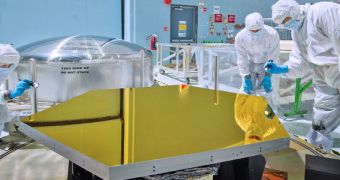NASA currently plans to launch its new flagship observatory, the James Webb Space Telescope (JWST), sometime in 2018. Before this extremely complex machine can fly, all of its components have to be integrated with its spacecraft bus. Recently, officials with the Goddard Space Flight Center (GSFC) in Greenbelt, Maryland, have just received all 18 mirrors that will go on the JWST.
This marks an important milestone for the project, which already features an impressive number of new technologies and capabilities. For example, the 18 mirror segments make up such a huge primary eye for the telescope that they cannot be launched in their final configuration on any existing or upcoming rocket. This is why the JWST will be the first telescope to be launched in a folded configuration.
Since the observatory is designed to see as far back into the history of the Universe as possible, it became immediately apparent that it required a set of eyes capable of picking up even the faintest traces of light. JWST has not one, not two, but three sets of mirrors, all of which can have their orientation controlled individually.
Boulder, Colorado-based Ball Aerospace & Technologies Corporation was the main subcontractor on all the mirrors, dealing with related optical technologies and with assembling the lightweight mirror system. The main contractor for the telescope is Northrop Grumman. The main eyes on this telescope are 6.5 meters (21.4 feet) across, more than twice the size of the Hubble Space Telescope.
Each of the 18 hexagonal mirror segments is 1.3 meters (4.2 feet) across and weighs less than 40 kilograms (88 pounds). Multiple layers make up each segment, ranging from the reflective gold-coated beryllium substrate to a beryllium structure of whiffles. A Delta frame keeps everything in place, and each mirror is attached to the Backplane Interface Flexures. Underneath via precision actuators.
“The complexity of the mirror assemblies comes from the fact that they are designed to be very lightweight, work at cryogenic temperatures below -400F [-240ºC], survive launch vibration and forces, be align-able on-orbit via actuators, and then stay aligned for up to two weeks as though they are a single large mirror,” says researcher Lee Feinberg.
The expert holds an appointment as the JWST Optical Telescope Element Manager at the GSFC. He says that each mirror segment boasts 6 actuators, and a larger, force actuator right at their center. This allows all components to align with each other perfectly and focus on a single point, as if they were in a fact a single, larger mirror.
NASA expects great things from the $8.8-billion (€6.4-billion) observatory. Astrophysicists and astronomers will use it to research the nature of dark matter, to study the history of the earliest stars and galaxies, and to look for exoplanets in orbit around distant star. JWST definitely has the potential to bring about a significant revolution in astronomy.

 14 DAY TRIAL //
14 DAY TRIAL //